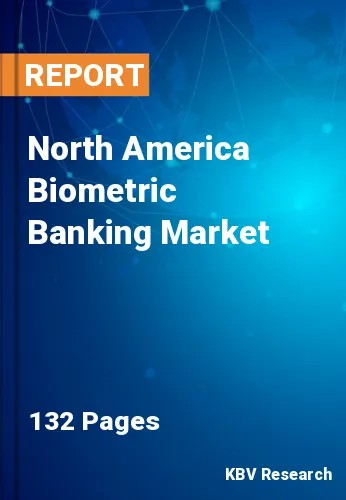The North America Biometric Banking Market would witness market growth of 15.8% CAGR during the forecast period (2023-2030).
The rapid adoption of artificial intelligence (AI) and machine learning (ML) presents a significant opportunity for the market. Algorithms that utilize machine learning aid to adapt to user behavior, thereby enhancing accuracy and efficiency. In addition, advancements in biometric sensors and algorithms increase the precision and dependability of biometric authentication. However, security concerns and high implementation costs are significant obstacles to the market's expansion. Integrating biometric solutions into existing banking infrastructure is complex and requires substantial investment.
Biometric banking provides customers enhanced security and convenience during login, transactions, and account access. In addition, the widespread utilization of smartphones equipped with biometric sensors, like fingerprint scanners and facial recognition cameras, has facilitated biometrics. As users become accustomed to using biometrics to activate devices and receive biometric authentication tokens for financial services, they will become more comfortable with the technology. Additionally, financial companies and banks are adopting novel security technologies consistent with regulatory guidelines, secure, cost-effective, and contributing to increased consumer satisfaction. Biometric authentication addresses consumers' three most important needs: convenience, efficiency, and security. It eliminates the need to memorize passwords or PINs, thereby maximizing comfort. A simple biometric scan is sufficient to prove an individual's identity, which is significantly more secure than tapping a card.
North American banks and financial institutions are increasingly interested in biometric technologies to enhance security and convenience for their customers. Biometric authentication methods, such as fingerprint, facial, and voice recognition, are being explored for various banking applications. Some banks in North America are experimenting with biometric authentication at ATMs. Customers can use their fingerprints or palm prints to access ATM services, making it more secure and convenient than traditional PIN-based systems.
The US market dominated the North America Biometric Banking Market, by Country in 2022, and would continue to be a dominant market till 2030; thereby, achieving a market value of $4,028.1 Million by 2030. The Canada market is exhibiting a CAGR of 18.4% during (2023 - 2030). Additionally, The Mexico market would experience a CAGR of 17.4% during (2023 - 2030).
Based on Type, the market is segmented into Fingerprint, Facial Recognition, Hand Geometry, Iris Recognition and Others. Based on Vertical, the market is segmented into Retail, Transportation, Hospitality, Government, Healthcare and Others. Based on Component, the market is segmented into Hardware, Software and Services. Based on countries, the market is segmented into U.S., Mexico, Canada, and Rest of North America.
Free Valuable Insights: The Worldwide Biometric Banking Market is Projected to reach USD 16.2 Billion by 2030, at a CAGR of 16.6%
The market research report covers the analysis of key stake holders of the market. Key companies profiled in the report include Google LLC, NEC Corporation, Apple, Inc., The Charles Schwab Corporation, Mastercard Inc., Barclays Plc, Visa Inc., PayPal Holdings, Inc., Samsung Electronics Co. Ltd. and Aliph Brands.
By Type
By Vertical
By Component
By Country
Our team of dedicated experts can provide you with attractive expansion opportunities for your business.

